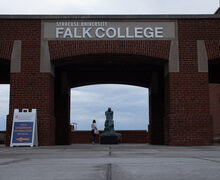Project team plans promotion of Dome rain collection system
The Carrier Dome bathroom is not a place one would typically expect to find inspiration.
Yet this is where Bruce Wanlass, principal engineer at C&S Companies, came up with an idea to help reduce the amount of rainwater runoff that flows into the Onondaga County sewage system. The plan is to capture the rainwater that collects on the north side of the Dome’s roof and to use it to flush toilets and urinals.
The team of engineers, designers and architects are well into the planning phase of the rainwater capture project. A number of companies are involved, including Environmental Design & Research (EDR), C&S Companies, Klepper, Hahn, & Hyatt Engineers and Syracuse University’s Campus Planning, Design and Construction.
They met inside the Dome Friday to discuss plans for promoting the system once it has been installed. The group talked about design schemes created by Tierney Latella and Sam Proctor, both communications design students at SU, for signage inside and outside the Dome.
Construction is tentatively set to begin in late June and be finished by Oct. 31, said Peter Sala, managing director of the Dome.
The team held its Friday meeting to figure out how to promote the new system.
Since the project is funded by a grant, the planners are required to have signs with information on the system.
Each attendee at a Dome event uses about two gallons of water, Wanlass said at the meeting. By the time the next SU football season starts, this water will be taken from Dome roof runoff.
The way it will work is the rainwater-harvesting system will collect approximately 15 percent of the 6,650,000 gallons of rainwater that fall on the Dome annually, Wanlass said. Since the gutters on its roof are heated, the Dome’s system can capture and recycle melted snow in addition to rainwater, he said.
“Because we’re melting snow all the time off our roof, we’ll constantly have a water source to fill the tanks,” Sala said.
Onondaga County runs on a combined sewage system, meaning that both waste and storm water run into the same pipeline, Wanlass said. He added that during storms, excess rainwater runs into the lake, causing overflow. The system will work to reduce this.
“Imagine 6.5 acres of roof up [on the Dome] — with all that rainfall, that water goes directly into the sewage system,” Sala said. “What the city and the county doesn’t want is all this water to come off…the roof and just overpower the storm sewers.”
The new system will retain the water in two 25,000-gallon cisterns and slowly release it over time to help prevent overflow, Wanlass said. But placing 25,000-gallon holding tanks is no small feat, especially on a campus as crowded as SU.
“Space has been a big challenge,” Sala said.
The team decided to place the tanks underneath the Q-1 parking lot near the Dome, north of Heroy Geology Building, Wanlass said. After the rainwater is harvested and stored in the underground tanks, it will be filtered, treated with chlorine and either UV or ozone, and pumped back into a smaller “day tank” inside the Dome, he said.
The tank will be displayed behind a glass window just inside the main entrance with further information on an electronic message display or other interactive feature, said Jane Rice, director of planning at EDR. The display is just one way to get the buzz about the system going.
The Dome will also be getting more colorful as this project progresses.
“When you capture and use rain water you have to dye it a color so that it’s easily recognizable,” said JoAnne Race, senior administrator in the Office of Sustainability Initiatives.
Wanlass and the design team are considering dying the water in the toilets and urinals blue, although the official decision on the color has not been made. In addition, the pipes will have to be painted.
Sala said by health code mandates, the pipes through which the rainwater flow must be a different color than the rest of the plumbing, so the pipes will be made purple.
Published on February 17, 2014 at 1:23 am




